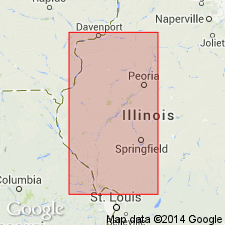
- Usage in publication:
-
- Carlinville cyclical formation
- Modifications:
-
- Original reference
- AAPG geologic province:
-
- Illinois basin
Summary:
Carlinville cyclical formation. [A name applied to a middle portion of McLeansboro formation (Pennsylvanian) of central-western Illinois, based upon the rhythmic-cycle theory of sedimentation. Includes Carlinville limestone. Origin of name not stated.]
Source: US geologic names lexicon (USGS Bull. 896, p. 348).
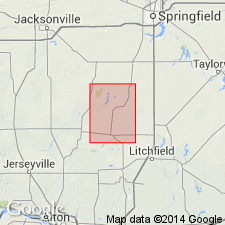
- Usage in publication:
-
- Carlinville cyclothem
- Modifications:
-
- Revised
- AAPG geologic province:
-
- Illinois basin
Summary:
Pg. 84-37. Carlinville cyclothem. Maximum exposed thickness to Carlinville quadrangle 37 feet. Includes Carlinville limestone. In sequence, Carlinville cyclothem overlies Trivoli cyclothem and underlies Burroughs beds. Name Shoal Creek has been used for the cyclothem in belief that Carlinville limestone was correlative of Shoal Creek limestone. However, recent studies have shown that Carlinville limestone is not correlative of Shoal Creek. Age is Pennsylvanian.
Source: US geologic names lexicon (USGS Bull. 1200, p. 638).
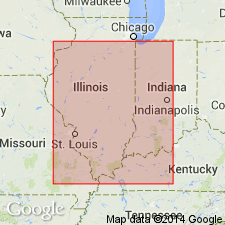
- Usage in publication:
-
- Carlinville cyclothem
- Modifications:
-
- Revised
- AAPG geologic province:
-
- Illinois basin
Summary:
Pg. 1764 (table 2). Table shows Carlinville cyclothem between the Macoupin above and the Trivoli below. Age is Pennsylvanian.
Source: US geologic names lexicon (USGS Bull. 1200, p. 638).
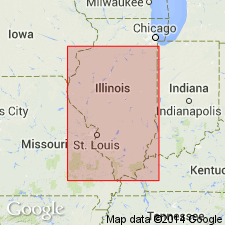
- Usage in publication:
-
- Carlinville cyclothem
- Modifications:
-
- Principal reference
- AAPG geologic province:
-
- Illinois basin
Summary:
Pg. 11. Carlinville cyclothem. Type locality designated in SW/4 SW/4 sec. 35, T. 10 N., R. 7 W., Macoupin Co., IL.
Source: US geologic names lexicon (USGS Bull. 1200, p. 638).
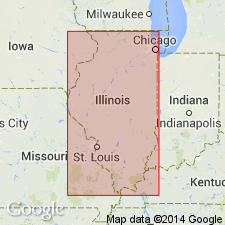
- Usage in publication:
-
- Carlinville cyclothem
- Modifications:
-
- Revised
- AAPG geologic province:
-
- Illinois basin
Summary:
Pg. 54 (table 3), pl. 1. Carlinville cyclothem. Occurs between Trivoli cylothem below and Macoupin cyclothem above in southwestern Illinois. Age is Pennsylvanian. Report presents new rock-stratigraphic classification of Pennsylvanian strata in Illinois. Cyclical classification retained but is entirely independent of rock-stratigraphic classification; includes rocks also assigned to Modesto formation (new) of McLeansboro group.
Source: Publication; US geologic names lexicon (USGS Bull. 1200, p. 638).
For more information, please contact Nancy Stamm, Geologic Names Committee Secretary.
Asterisk (*) indicates published by U.S. Geological Survey authors.
"No current usage" (†) implies that a name has been abandoned or has fallen into disuse. Former usage and, if known, replacement name given in parentheses ( ).
Slash (/) indicates name conflicts with nomenclatural guidelines (CSN, 1933; ACSN, 1961, 1970; NACSN, 1983, 2005, 2021). May be explained within brackets ([ ]).

